1. Aqueous solutions of acids are (electrolytes, nonelectrolytes), meaning that they conduct an electrical current. Some acids are (weak, strong) electrolytes because they ionize completely in water, yielding a great many ions. Other acids are (strong, weak) electrolytes that exist primarily in a non-ionized form when dissolved in water. 2. Acids have a (sour, bitter) taste. Lemons, vinegar, and sour candies all contain acids. 3. Acids change the color of certain acid-base indicators. Two common indicators are litmus and phenolphthalein. Blue litmus turns (red, blue, colorless) in the presence of an acid, while phenolphthalein turns (colorless, red, blue).
Ionic Equilibrium
Chemical equilibrium and ionic equilibrium are two major concepts in chemistry. Ionic equilibrium deals with the equilibrium involved in an ionization process while chemical equilibrium deals with the equilibrium during a chemical change. Ionic equilibrium is established between the ions and unionized species in a system. Understanding the concept of ionic equilibrium is very important to answer the questions related to certain chemical reactions in chemistry.
Arrhenius Acid
Arrhenius acid act as a good electrolyte as it dissociates to its respective ions in the aqueous solutions. Keeping it similar to the general acid properties, Arrhenius acid also neutralizes bases and turns litmus paper into red.
Bronsted Lowry Base In Inorganic Chemistry
Bronsted-Lowry base in inorganic chemistry is any chemical substance that can accept a proton from the other chemical substance it is reacting with.

Step by step
Solved in 2 steps









